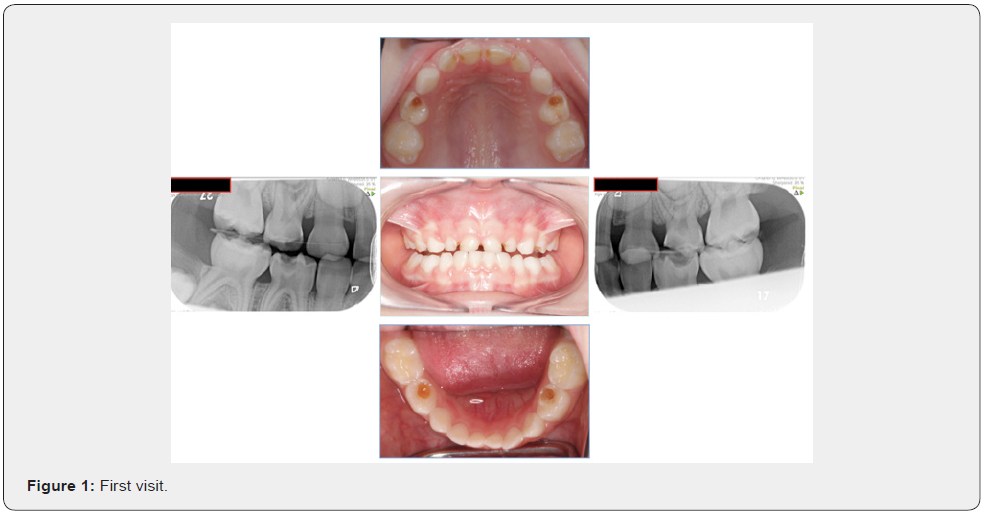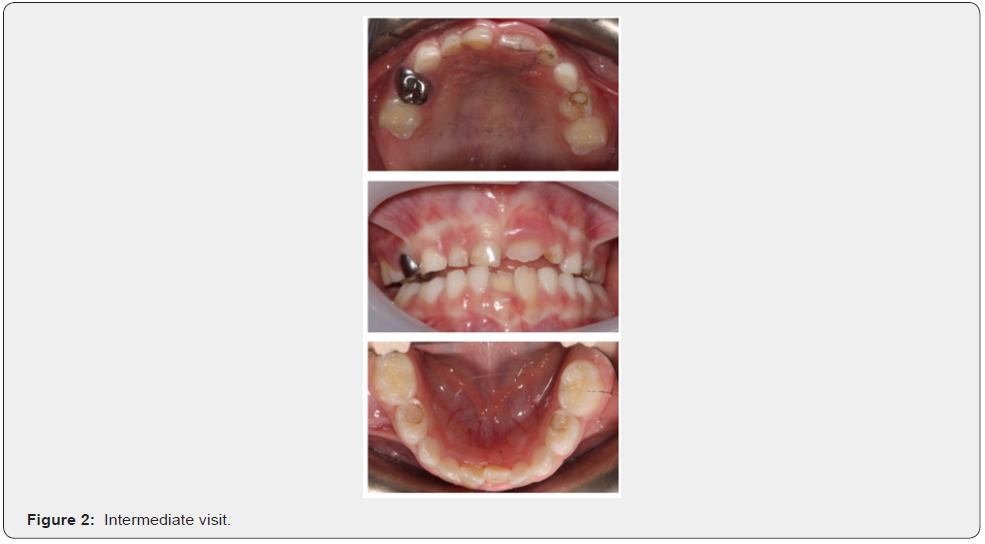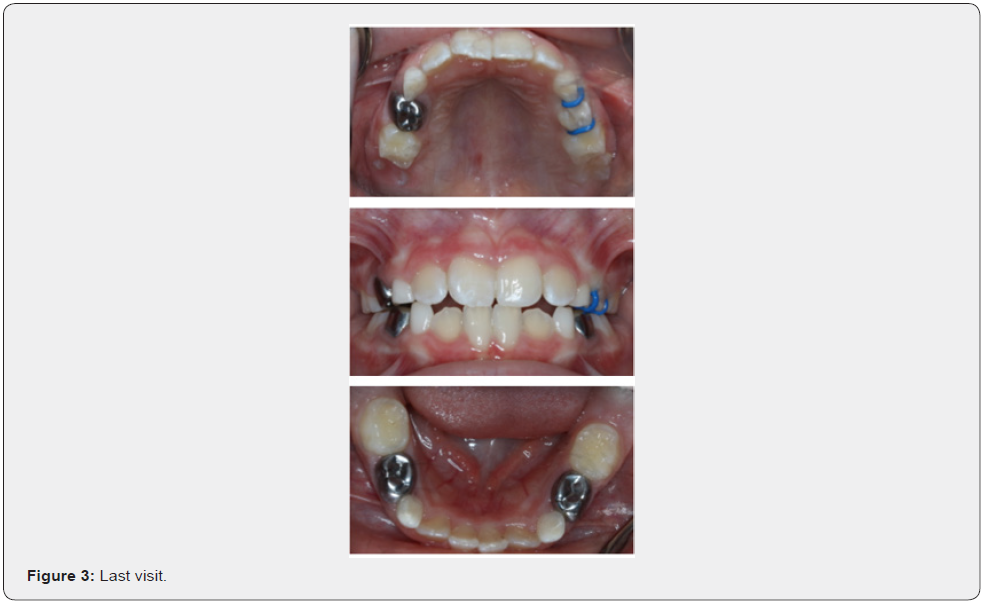The Importance of First-visit caries stabilization / ITR in managing high caries-risk children: A Case Report
Alhassan Ali Alshehri*
Public Health & Pediatric Dentistry Consultant, Head, Pediatric Dentistry Department, North of Riyadh Dental Center, Second Health Cluster, Riyadh region, Ministry of Health, Kingdom of Saudi Arabia
Submission: November 14, 2022; Published: November 29, 2022
*Corresponding author: Alhassan Ali Alshehri, Public Health & Pediatric Dentistry Consultant, Head, Pediatric Dentistry Department, North of Riyadh Dental Center, Second Health Cluster, Riyadh region, Ministry of Health, Kingdom of Saudi Arabia
How to cite this article: Alhassan A A. The Importance of First-visit caries stabilization / ITR in managing high caries-risk children: A Case Report. Adv Dent & Oral Health. 2022; 15(5): 555923. DOI: 10.19080/ADOH.2022.15.555923
Abstract
The narrow approach to only address chief complaint, for high-caries-risk patient with multiple carious lesions, can be costly on patient, clinicians and healthcare services on the long term. Encouraging comprehensive approach of both primary and secondary prevention with caries stabilization in first visits for such patients should always be the best clinical practice standards. Particularly in this time of huge demand on dental services and long waiting lists. This case report aims to demonstrate how both primary and secondary prevention with stabilization of dental caries in the 1st visit proved crucial to preserve the state of oral health and avoid preventable consequences of untreated cavitated dental caries.
Keywords:Caries stabilization; ITR; Dental caries prevention; Secondary prevention; OHI
Abbreviations:ITR: Interim Therapeutic Restoration; GDP: General Dental Practitioner; GIC: Glass Ionomer Cement; SSC: Stainless Steel Crowns
Introduction
The World Health Organization recommend the use of stabilization as an Interim Therapeutic Restoration (ITR) technique to restore, arrest or prevent the progression of dental caries and its preventable consequences if left untreated Frencken [1], WHO [2]. Furthermore, The American Academy of Pediatric Dentistry endorse caries stabilization or ITR as a provisional beneficial technique for restoring and preventing caries AAPD [3]. This proves important when the clinical circumstances make it challenging to provide conventional restorative treatment, especially when high caries-risk patients attend their first visit with multiple carious teeth, that needs to be treated over several visits Wright & Welbury [4]. There are several reasons that might render providing conventional interventions on time especially for pediatric patients or those with special health care needs. For instance, when patient anxiety or cooperation doesn’t allow to deliver restorative care safely where pharmacological behaviour managements, such as relative or general anaesthesia, are not available. Another example is when clinician need to defer treatment until child acclimatization established Innes [5]. This particularly important when there is huge demand on clinical services and long waiting lists to enable seeing patient more frequently in clinics and provide needed conventional care. The caries stabilization or ITR procedure involves removal of caries using either hand excavator or slow speed hand-piece rotary instrument AAPD [3].
Case Report
An intelligent active 4 years old girl attended the pediatric dental department, brought by her mother and referred by the General Dental Practitioner (GDP) for Specialist Pediatric dental care due to poor cooperation and behaviour management issues. Medically she is fit and well. Clinical and radiographic examination revealed fair oral hygiene of primary dentition with Severe - Early Childhood Caries affecting all 1st primary molars and upper primary incisors (Figure 1). All carious teeth from signs and symptoms are capable of healing and caries ingress are not into the pulp yet.
Initially at the first visit acclimatization of the child and positive dental attitude was achieved with use of non-pharmacological behaviour management techniques, a prevention regime instigated and rehearsed with both the child and the mother. Moreover, since carious 1st primary molars were not into the pulp that warrant invasive pupal therapy, stabilization with Glass Ionomer Cement (GIC) were done for teeth # 54, 64, 74, & 84 after acclimatization on the first visit to arrest, restore and prevent lesion progression into the pulp. Owing to the gained positive cooperation, treatment was provided through multiple visits using several behaviour management techniques. Teeth # 52, 51, 61, & 62 received composite restorations; and tooth # 54 was restored with Stainless Steel Crowns (SSC). Then the patients missed her follow appointments for more than 6 months. After that she came to dental clinic to continue needed treatments where teeth # 74, & 84 were restored with SSC (Figure 2), as shown in the figure the stabilized teeth with GIC remained intact. It should be noted that oral hygiene instructions and preventive advices were reinforced in each visit, in addition to polishing, and fluoride varnish application.


However, the child and her family changed their home address where they no-longer received the appointment letters sent to them for the next visit. This resulted in a gap of treatment continuity, where the stabilized tooth #64 left uncovered with a definitive treatment (i.e., stainless-steel crown, in this case) for more than 11 months until the hospital re-established contact with the child and her family (Figure 3).

Results
After almost a year of interruption of treatment, the child visited the clinic where oral health examination revealed good oral hygiene of a newly mixed dentition with no new carious lesion evident. More importantly, the uncrowned stabilized primary upper left 1st molar (tooth #64) was intact with no pulpal or infection consequences (Figure 3).
Conclusion
From presented case, it can be concluded that ensuring caries stabilization/ ITR of cavitated carious lesion is done on first visit, especially with high caries-risk patients, and enforcing both primary and secondary prevention in line with established prevention guidelines serves as the best practice as well as in the best interest for patients and healthcare services alike. Where in that case if otherwise, the child may need to visit the emergency services due to pain or infection swelling where more invasive procedures such as pulpectomy or even extraction under general anasethesia might be needed. Consequently, if not cooperative enough for such procedure, the child will be listed for hospitalbased dentistry and adding to the long lists of admissions on top of the burden of the pain that the child and her family might be suffering from. Finally, it is of crucial importance to constantly and appropriately rehearse oral hygiene advice with both the child and the parent Deery & Toumba [6]; Fayle [7]; DoH [8]; specially that not all parents are aware of the importance of oral hygiene and fluoridated toothpaste Watt & Sheiham [9].
References
- Frencken J, Van Amerogen E, Phantumvanit P, Songpaisan Y, Pilot T (1997) Manual for the Atraumatic Restaurative Treatment approach to control dental caries. Dental Health International Nederlant ISBN90-803296-1-4.
- World Health Organization (2017) WHO expert consultation on public health intervention against early childhood caries: report of a meeting, Bangkok, Thailand, 26-28 January 2016.
- American Academy of Pediatric Dentistry (2022) Policy on Interim Therapeutic Restorations (ITR). Pediatr Dent.
- Wright G, Welbury R (2016) Paediatric Dentistry. Chapter in Churchill's Pocketbooks Clinical Dentistry E-Book. Edited by Scully C. Elsevier Health Sciences.
- Innes NPT, Evans DJP, Bonifacio CC, Geneser M, Hesse D, et al. (2017) The Hall Technique 10 years on: Questions and answers. British Dental Journal 222(6): 478-483.
- Deery C, Toumba K (2012) Diagnosis and prevention of dental caries. Paediatric dentistry 3(2): 10-129.
- Fayle S (2012) Treatment of dental caries in the preschool child. Chapter in: Welbury R, Duggal MS, Hosey MT eds., Paediatric dentistry. Oxford University Press.
- (2017) Department of Health (DoH). Delivering Better Oral Health: An evidence-based toolkit for prevention. British Association for the Study of Community Dentistry, first published 2014.
- Watt R, Sheiham A (1999) Health policy: Inequalities in oral health: a review of the evidence and recommendations for action. British dental journal 187(1): 6-12.






























